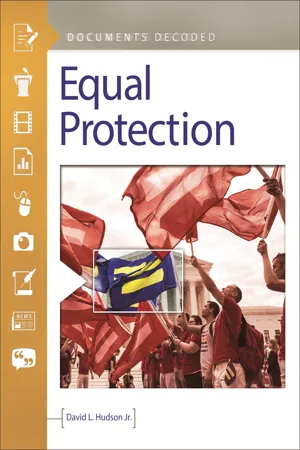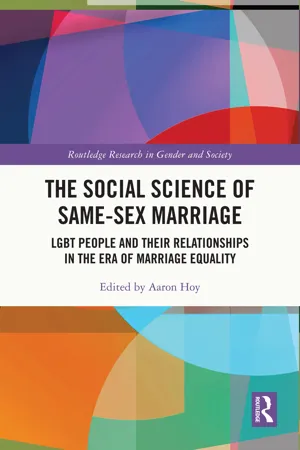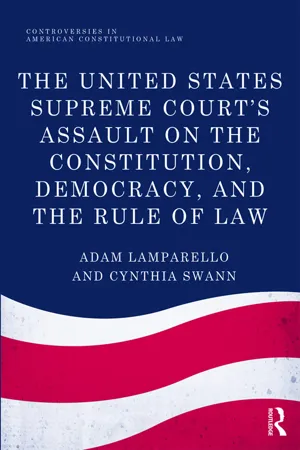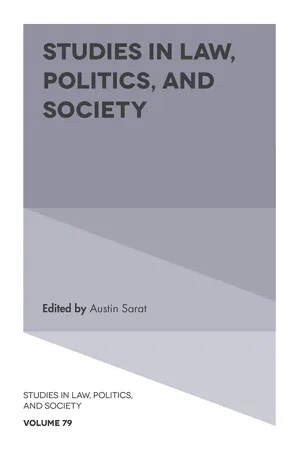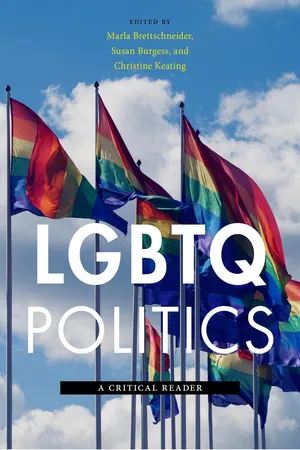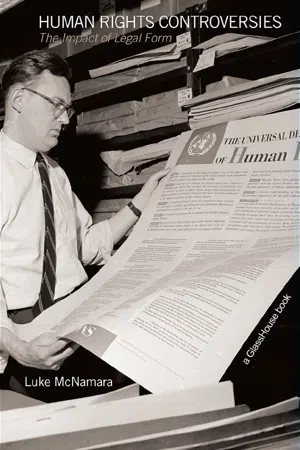Politics & International Relations
Obergefell v. Hodges
"Obergefell v. Hodges" was a landmark U.S. Supreme Court case in 2015 that legalized same-sex marriage nationwide. The case challenged state bans on same-sex marriage and argued that they violated the Fourteenth Amendment's Equal Protection Clause. The Court's ruling established marriage equality as a fundamental right, marking a significant milestone in the LGBTQ+ rights movement.
Written by Perlego with AI-assistance
Related key terms
7 Key excerpts on "Obergefell v. Hodges"
- eBook - ePub
Equal Protection
Documents Decoded
- David L. Hudson Jr.(Author)
- 2018(Publication Date)
- ABC-CLIO(Publisher)
Obergefell v. Hodges June 26, 2015INTRODUCTIONOne of the most landmark decisions in recent memory by the U.S. Supreme Court is Obergefell v. Hodges (2015). In this decision, the court struck down same-sex marriage bans as violative of both the due process clause and the equal protection clause.In the early 1990s, the Hawaii Supreme Court had questioned the constitutionality of a same-sex marriage ban, and a decade later, the Supreme Judicial Court of Massachusetts had explicitly struck down its state ban on same-sex marriages under the Massachusetts Constitution. After that decision, many other states had also invalidated bans on same-sex marriage.However, other states adamantly refused to legalize same-sex marriage or even to recognize same-sex marriages from other countries. This resulted in a state of legal uncertainty for many same-sex couples. Eventually, the U.S. Supreme Court would address the question—and the justices finally did in the Obergefell decision.Justice Kennedy 1 delivered the opinion of the Court.The Constitution promises liberty to all 2 within its reach, a liberty that includes certain specific rights that allow persons, within a lawful realm, to define and express their identity. The petitioners in these cases seek to find that liberty by marrying someone of the same sex and having their marriages deemed lawful on the same terms and conditions as marriages between persons of the opposite sex.. . . These cases come from Michigan, Kentucky, Ohio, and Tennessee ,3 - eBook - ePub
The Social Science of Same-Sex Marriage
LGBT People and Their Relationships in the Era of Marriage Equality
- Aaron Hoy, Aaron Hoy(Authors)
- 2022(Publication Date)
- Routledge(Publisher)
Chapter 1 From the political to the personal: LGBT people and their relationships in the era of marriage equality An introduction Aaron HoyDOI: 10.4324/9781003089995-1On June 26, 2015, the US Supreme Court issued its decision in Obergefell v. Hodges, the landmark case that finally, after decades of activism and struggle, legalized same-sex marriage across the US. At the time, I was a graduate student in sociology living in Syracuse, New York. When I first saw the headline announcing the decision on Facebook, I instantly leapt up and rushed downtown to join a victory rally that had been planned days in advance by several community organizations and activists. Similar rallies popped up all over the country, as lesbian, gay, bisexual, and transgender (LGBT) people and their allies celebrated a hard-fought victory that had been many years in the making. In Syracuse, excitement filled the air, as if those who had gathered could not contain their overwhelming joy. Smiles beamed as people offered kind words of congratulations and hugs to others, most of them likely total strangers. As they drove by, cars honked their horns in support, and even a few police officers flashed their lights and sounded their sirens, a sign of support that I remember thinking stood in stark contrast to the hostility LGBT people often experience with police. After an hour or so, the crowd surrounded the steps of a historically progressive church and listened attentively as a handful of local marriage equality activists spoke about the various meanings of the Obergefell decision – how it represented, among other things, a triumph of love over hate, respect and security for LGBT people and their families, and a major step toward full equality for the LGBT community. No matter how they interpreted the decision, most at the rally seemed to agree that Obergefell - eBook - ePub
- Adam Lamparello, Cynthia Swann(Authors)
- 2016(Publication Date)
- Routledge(Publisher)
The Court’s decision in Obergefell should alarm citizens of all political persuasions and should offend anyone who believes that the individual, not the Court, has the right to “define one’s own concept of existence, of meaning, of the universe, and of the mystery of human life.”Planned Parenthood, 833 U.S. at 851. American constitutional law now allows the judges to do and say whatever they want – with impunity. As Justice Alito stated in his dissenting opinion, “[m]ost Americans – understandably – will cheer or lament today’s decision because of their views on the issue of same-sex marriage,” although “all Americans, whatever their thinking on that issue, should worry about what the majority’s claim of power portends.” 66 Obergefell in the broader societal and cultural context Like Griswold, the Court’s decision in Obergefell appeared to be a response to the changing cultural and social climate in the United States. In the mid to late 1990s, lower federal and state courts, as well as legislatures in some states, created “civil unions” that provide same-sex couples with benefits similar to those afforded opposite-sex couples. Additionally, in the first decade of the twentieth century, a small number of lower federal and state courts, relying in substantial part on Lawrence, began to invalidate same-sex marriage bans, holding that such bans violated the Due Process and Equal Protection Clauses of the Fourteenth Amendment. In 2013, arguably in response to the changing public attitudes toward same-sex unions, the Court decided Windsor, in which it invalidated a provision of the federal Defense of Marriage Act that restricted the definition of “marriage” to opposite-sex couples. In Windsor ’s aftermath, the judiciary’s and public’s support for same-sex marriage strengthened, as several federal courts of appeal invalidated bans on same-sex marriage and opinion polls showed that a slight majority of Americans supported extending the right to marry to same-sex couples - eBook - ePub
- Austin Sarat, Austin Sarat(Authors)
- 2019(Publication Date)
- Emerald Publishing Limited(Publisher)
17Robert’s narrative casts the Court as the unruly instigator of political conflict and, by contrast, those with lingering discomforts about same-sex marriage as the protectors of the tradition of American deliberative politics and democratic decision-making. Ultimately, the Chief Justice all but invites opponents of same-sex marriage to agitate not only against Obergefell but against the Court itself and, by extension, against an entire branch of government that appears increasingly controlled by a caste of elites, eager to remake society “according to its own ‘new insight’ into the nature of injustice” (Obergefell v. Hodges , 2015, p. 3). “[H]owever heartened the proponents of same-sex marriage might be on this day,” admonishes Roberts, “it is worth acknowledging what they have lost, and lost forever, the opportunity to win the true acceptance that comes from persuading their fellow citizens of the justice of their cause” (Obergefell v. Hodges , 2015, p. 27). Even as he acknowledges the “considerable success” that same-sex marriage supporters have achieved in persuading fellow citizens through the democratic process to adopt their view, Roberts darkly assures such Americans that this trajectory of success “ends today” (Obergefell v. Hodges , 2015, p. 2).It is in the immediate wake of these predictions that Roberts turns to the matter of religious free exercise – and, more specifically, to his indictment of the majority’s dissimulating assurance of free exercise protection for those opposed on religious grounds to the legalization of same-sex marriage. “Many good and decent people oppose same-sex marriage as a tenet of faith, and their freedom to exercise religion is – unlike the right imagined by the majority – actually spelled out in the Constitution” (Obergefell v. Hodges , 2015, p. 27). Roberts’ admonition does not merely furnish an opening into his critique of the “belief-centered” formulation of religion that Kennedy proffers to traditional marriage advocates in the face of their legal defeat, it offers a forceful reminder to his audience that, in the ensuing conflict between supporters and opponents of same-sex marriage, only one of these camps has the plain text of the Constitution on its side. In this sense, he places Obergefell at the center not merely of a burgeoning conflict between supporters and opponents of same-sex marriage but a more far-reaching conflict between the free exercise clause and the very branch of government tasked with defending it. It requires little stretch of the imagination to perceive the manner in which such a depiction invites a particular reader to think of Obergefell - eBook - ePub
- Frances Hamilton, Guido Noto La Diega, Frances Hamilton, Guido Noto La Diega(Authors)
- 2020(Publication Date)
- Routledge(Publisher)
68Conclusion
This is an area that lacks certainty that can only really begin to be achieved through harmonisation as a consequence of large-scale migration. Regardless of this need for change, it is anticipated that, as a result of some Member States taking a very different view of same-sex marriage than others, such an approach could be criticised for going ‘too far, too fast.’ The pragmatic reality is rather different; Obergefell, combined with the recent decision in Coman, demonstrates that harmonisation is achievable in spite of the potential for resistance from some Member States.In making its judgement in Obergefell, the US Supreme Court recognised the uncertainty faced by same-sex couples crossing state borders, and the problems they may face as a consequence of non-recognition of their marital status. They, therefore, sought to rectify this despite the controversy that would surround such a decision. In doing so, they act as a comparator and an example of what can be achieved. With a very similar landscape in respect of differing state laws, the court was able to achieve harmonisation of a higher order than that proposed for the EU, by harmonising substantive law on the area. This, in turn, demonstrates that the proposition is achievable, which is then furthered by the recent judgement in Coman, as all Member States are now required to recognise same-sex marriage for at least one purpose. Straddling these cases, it is argued that harmonisation of the choice of law rules for same-sex relationships across the EU is achievable. Whilst some commentators may criticise such an approach,69 Obergefell is a precedent for harmonisation within this area, and provides evidence that this is essential and should be achieved. This is furthered by the Coman decision, which requires all Member States to recognise same-sex marriages for the purpose of free movement, and acts as a stepping stone to the further recognition required in terms of all same-sex marriages being recognised that have been lawfully entered into, and have been subsisting for a reasonable period of time. Thus, whilst criticism may be levelled at the recommendation of harmonisation, the combined effect of Obergefell and Coman - eBook - ePub
LGBTQ Politics
A Critical Reader
- Marla Brettschneider, Susan Burgess, Christine Keating(Authors)
- 2017(Publication Date)
- NYU Press(Publisher)
In response to arguments that same-sex marriage foreclosed democratic processes, Justice Kennedy wrote, [T]here has been far more deliberation than this argument acknowledges. There have been referenda, legislative debates, and grassroots campaigns, as well as countless studies, papers, books, and other popular and scholarly writings. There has been extensive litigation in state and federal courts.… Judicial opinions addressing the issue have been informed by the contentions of parties and counsel, which, in turn, reflect the more general, societal discussion of same-sex marriage and its meaning that has occurred over the past decades. As more than 100 amici make clear in their filings, many of the central institutions in American life—state and local governments, the military, large and small businesses, labor unions, religious organizations, law enforcement, civic groups, professional organizations, and universities—have devoted substantial attention to the question. (Obergefell v. Hodges, slip op. 23) Obergefell met considerably more controversy than Lawrence, but I do not anticipate Roe -type backlash because, in the main, same-sex marriage was vetted more fully in political discourses and accepted by a majority of Americans before the Court acted. The same Roe Court could have recognized same-sex marriages in 1972 when two men challenged Minnesota laws denying them the right to marry. Instead, the Court declined even to recognize that the issue of same-sex marriage involved federal constitutional questions, neither questions of liberty nor questions of equality. The Court dismissed the case “for want of a substantial federal question” (Baker v. Nelson 1972). Only three years after Stonewall, public support for same-sex marriage would have been as negligible as the Court suggested. Not until the tide of public support for same-sex marriage tipped 50 percent did the Court grant certiorari for same-sex marriage controversies - eBook - ePub
Human Rights Controversies
The Impact of Legal Form
- Luke McNamara(Author)
- 2007(Publication Date)
- Routledge-Cavendish(Publisher)
222 At least at the federal level, the same observation applies with equal force to Australia.The contrast between Canada and the other two countries that are the subject of the present study is less striking, but nonetheless significant. In the UK and New Zealand, a human rights dynamic centred on Art 14 of the ECHR and s 19 of the Bill of Rights Act, respectively, was influential in generating political momentum towards the legislative recognition of same-sex relationships as civil partnerships/civil unions. Consistent with the statutory bill of rights models adopted in these two countries, the role of the judiciary was less significant than it was in Canada. This was particularly so in New Zealand where the courts’ main contribution was to place marriage ‘off limits’ as a BORA-inspired goal, thereby redirecting the relationship recognition movement to the goal of civil union, and to the strategy of legislative reform. In this setting the human rights dynamic was an important part of the environment in which the Civil Union Act 2004 came to be seen by a majority of parliamentarians as a logical extension of New Zealand’s commitment to fundamental human rights values. To the extent that the BORA was seen to create a legal imperative – and there was a dimension of the public discourse that emphasised that same-sex relationship recognition was a necessary consequence of New Zealand’s obligations under the BORA and the Human Rights Act 1993 – it was an imperative over which the executive and legislative arms of government exercised significant control. While the demands of legislative obligation and philosophical commitment may have combined to make the case for legislative recognition difficult to resist, there was still room in the policy-making process for other values and pragmatic considerations to be influential. In this context, a civil union regime, available to both same-sex and opposite-sex couples, which left marriage undisturbed as a heterosexual institution, marked the limits of the achievable.
Index pages curate the most relevant extracts from our library of academic textbooks. They’ve been created using an in-house natural language model (NLM), each adding context and meaning to key research topics.
